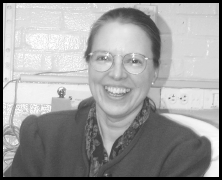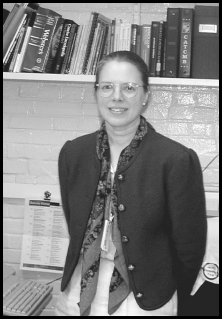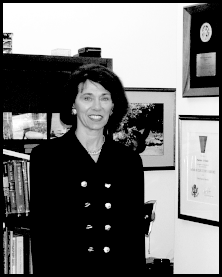NURSING
RESEARCH:
NEW DIRECTIONS FOR THE 21ST CENTURY
by Fran Pollner
| S |
But at first she perceived them as driving in different directions, science taking her exclusively to the laboratory, clinical practice to the bedside. It became a choice she had to make. She started out as a chemistry major at East Carolina University in Greenville, envisioning a career in research chemistry, and graduated with honors from that institution with a bachelor of science in nursing. She chose patient care.
In the nearly two decades since Wysocki became a nurse and an active investigator, however, she's proved to herself and the world at large that doing science and being a nurse are not mutually exclusive.
In fact, Wysocki finds that the practice and the research enlarge one another in critical ways, to the benefit of nursing and all medical science and practice.
Annette Wysocki |
When she accepted the position of NINR director, Grady also assumed the designation as "acting scientific director" of the institute until she could recruit NINR's first permanent scientific director, a nurse-scientist who would shape and strengthen the NINR intramural research program and commit herself as well to training a new generation of nurse scientists.
Wysocki, formerly director of nursing research at New York University and an NINR-funded investigator, answered the call and arrived in mid-September this year. Although the end of the fiscal year is not an auspicious time to secure supplies, she began - with gusto - to set up her lab, "the first Nursing Institute lab ever on the NIH campus," she remarks. But not the last. Both she and Grady see a major expansion in the next few years in the NINR intramural research program. The 2% of the NINR budget that intramural research currently commands will surely expand, Grady asserts, projecting the initiation of five or six research protocols - clinical and basic - over the next couple of years and the recruitment of more intramural scientists.
"We're interested in bringing young extramural people here as postdocs - and people in mid-career who want to learn new things," Grady says. "A critical issue in this field," she adds, "with so many young people wanting training, is that our mentors are overworked. What we're trying to do is get each mentor to train their trainees to be mentors."
NINR has also pioneered a summer course to teach nurses how to do clinical research and how to secure a research grant. Four hundred applied for 25 slots the first time around two summers ago, Grady recounts. This past summer, there were 50 slots available.
Annette Wysocki |
Wysocki is talking to other scientific directors about creating a training program for nurses who want to pursue research in areas that fall within their purview. "We want to sponsor IRTAs in labs and branches across the campus. In the immediate future, I'd like to recruit up to four IRTAs - ideally for three years and certainly no less than two years - and then expand that number. There needs to be a more formal pathway created for scientists who are nurses and are interested in doing bench-based research, and that's one of the reasons I took this position," Wysocki says.
In her own research, Wysocki is on the front-lines of wound healing. Following are excerpts from an interview last month with the new NINR scientific director.
Q: What ignited your interest in research?
Wysocki: I was a staff nurse at the University of Virginia Medical Center in Charlottesville, and there happened to be clinical research studies on pain being conducted on our unit. That peaked my research interest and kept it alive. But I also knew that I needed to obtain an advanced degree to become a principal investigator; a baccalaureate was not going to be enough.
Q: Because you wanted to do clinical research?
Wysocki: Because I wanted to do research with implications for patients.
Q: What's the pathway to basic research when your initial preparation is in nursing?
Wysocki:There are courses and programs in cell and molecular biology that nurses who want to become trained in basic science research can enroll in, just as any other medical or undergraduate student would. And they can engage in research training opportunities here at NINR/NIH or at their own university.
Q: What would distinguish a nurse's approach to cell and molecular biology from a physician's? What's the difference between an M.D./Ph.D. and an R.N/Ph.D?
Wysocki:The boundaries here are very fuzzy. But the problems that nurses identify and choose to study arise from working directly with patients on a day-to-day, 24-hour-a-day basis. We're on the front-lines delivering care directed at the relief of pain and treatment of wounds. We are the only practitioner that provides continuous monitoring and observation of patients, minute to minute, hour to hour. This creates powerful clinical observations that drive the research questions that nurses formulate - basic research questions and other types of questions. We have an intimate knowledge of what's going on with the patient - biologically, physically, emotionally, ethically, and with their families.
I've been studying wounds since 1984, before my postdoc. My doctoral work involved a wound healing study, but in the course of doing that study, I realized I needed cell and molecular biology, so I did a postdoc in the Department of Cell Biology and Anatomy at the University of Texas-Southwestern Medical Center in Dallas and at Cornell University Medical College in the Surgery Department [both as an NIH postdoctoral research fellow].
Because of my clinical background, I concentrated on the clinical questions. That's what was driving my science. But now my science is driving my clinical practice to some extent, because we're starting to find some interesting things that may have clinical implications.
Q: Is your coming to NIH a reflection of a new approach for the Nursing Institute?
Wysocki:Definitely. My coming here reflects a greater emphasis on a research program not only with a clinical component but a solid laboratory component to stand behind the clinical questions. We want to build on the clinical studies that were carried out previously at the Clinical Center and create a solid training pathway for future research scientists.
Pat Grady |
Wysocki: Pain is still a hot topic for us, and it will continue to be as Americans grow older and suffer from chronic conditions, especially from the vantage of home care, since patients are discharged earlier to their homes in the care of nurses.
There's a whole host of problems and opportunities: immobility stress, relaxation, sleep, loss of appetite, nausea, dementia, depression, and recovery from stroke. And, of course, chronic wound care is still a big problem in this country, costing approximately $9 billion a year.
I'm interested in chronic nonhealing or slow-healing wounds, in the clinical context of leg ulcers, which arise for a variety of reasons, and pressure sores - especially related to spinal cord injury, which I'd like to work on with the Paralyzed Veterans of America.
Q: How will you pursue that?
Wysocki:We'll be setting up clinical protocols to recruit patients with leg ulcers. In addition to the clinical workup, I collect wound fluid and tissue samples and bring these materials into my lab to be analyzed to see what it is that's not occurring in these wounds that does occur in wounds that heal normally - after surgery or following a relatively minor scrape. At the moment, I'm interested in looking at proteases, specifically matrix metalloproteases. My work has shown that there's an overexpression of matrix metalloproteases in chronic wounds - not all of them, but some of them.
And what I see in the lab makes me see the wounds clinically all over again. It's exciting. It makes them new again.
Q: Can you look at a patient clinically and estimate what the odds are of normal wound healing? Can you anticipate difficulty based on the kind of patient you see or what the wound looks like?
Wysocki:I couldn't do that confidently yet. I've always wanted to do an epidemiological study of wounds, to look at other risk factors. Looking at you today, I can't predict if you'll have problems with leg ulcers as you get older - unless you have diabetes or a circulatory impairment.
Q: Would you describe your research as basic, clinical, or a combination?
Wysocki: It's a hybrid. I'm dancing on both sides of the aisle. I think basic science takes a reductionist approach, which is useful to look at mechanisms, give you a basic understanding. But at some point, in this multifactorial world, you have to be an integrationist. There are going to be predominating factors, and you have to find out which ones are winning on an in vivo level, on a patient level.
Anyone who's doing science that has relevance for human health has to be both a reductionist and an integrationist to have the greatest impact.
Research Fellowships Beckon from Japan
The JSPS Short-term Fellowship provides for stays of 7 to 60 days; the JSPS Short-term Postdoctoral Fellowship runs from 3 to 11 months. Applicants must be U.S. citizens or permanent residents and research plans must be arranged in advance with the Japanese host. The application deadline is January 30, 1998. Interested persons should contact the FIC immediately to receive detailed program information and application instructions. Requests should be addressed to: Allen Holt or Christina McLauchlan at 496-4784; fax:480-3414; e-mail: <jsps@nih.gov>. |


